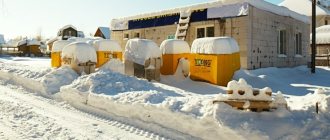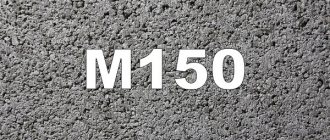The construction of any type of building does not involve pouring concrete, the main advantage of which is its high compressive strength. But you cannot load a specific part; first you need to wait for the concrete to complete its strength.
This process is influenced by many factors, including not only environmental conditions, but also the characteristics of the concrete itself.
For this material to reach its maximum strength, it takes about 28 days. To ensure greater durability of the structure, you need to understand how this process occurs and how much time it requires to complete.
IT consists of two stages. In the first, the concrete sets, and in the second, it finally hardens and gains strength.
Strengthening schedule
The time required for concrete to gain optimal strength indicators is determined by different conditions. This is called the curing period of the concrete solution. Only after complete hardening is a protective layer applied to the structure. The strength gain schedule is determined by the time during which the composition will completely harden.
The standard hardening time for concrete is 28 days. The greatest intensity of hardening occurs in the first five days. After a week, the indicative strength is 70% of the final one. In this case, it is prohibited to continue construction. Work is possible only after 28 days.
Concrete is poured under different conditions. They are the ones that affect the time taken to gain strength indicators. During the warm season, the composition is first kept in formwork. Then the concrete matures without it.
Thanks to this, concrete gains the necessary physical properties. If work is carried out in cold weather, the required grade strength can be achieved by additional heating of the material. Polymerization slows down if the ambient temperature is reduced.
Sand concrete is often chosen, the ratio of binder to water in which is quite low. This allows you to accelerate the development of strength indicators and reduce the holding time interval. If you make the ratio of water to cement ¼, the hardening time can be halved. The same goal is achieved by adding plasticizers.
To create a reliable and durable design, it is necessary to comply with all the requirements of the selected technology. The process takes place in two stages. The first reflects the process of setting the material. Strengthening represents the second stage.
Strength of concrete at different curing times at different temperatures
We present a table to display the relative strength of concrete (the strength of 28-day concrete hardening at +15 degrees C is taken as one unit) at different curing times at different temperatures
| Concrete hardening time, days | 5 ⁰С | 10 ⁰С | 15 ⁰С | 25 ⁰С | 35 ⁰С |
| 3 | 0,15 | 0,2 | 0,3 | 0,37 | 0,45 |
| 5 | 0,25 | 0,32 | 0,45 | 0,54 | 0,6 |
| 7 | 0,35 | 0,44 | 0,6 | 0,7 | 0,72 |
| 10 | 0,45 | 0,52 | 0,7 | 0,77 | 0,77 |
| 15 | 0,55 | 0,65 | 0,8 | 0,85 | 0,85 |
| 28 | 0,8 | 0,92 | 1 | 1,05 | — |
For individual builders who have not yet gained experience, the following rule can be given: If the average daily temperature is expected to be below +5⁰C for the next 28 days, pouring a foundation is not recommended.
It is unacceptable to leave a shallow and non-buried foundation for the winter without a load. If this does happen, you need to properly insulate the foundation itself and the soil near it with any bulk thermal insulation - expanded clay, slag, or mineral wool, in any way to reduce the freezing of the soil near the foundation. All reinforcement outlets from the foundation also need to be insulated to their full height.
There are cases when it is necessary to concrete in winter - this may be due to the prices of materials, the impossibility of delivery in the warm season, or due to the characteristics of the foundation soil. Methods and technology for winter concreting and heating of concrete is a long separate topic.
Setting stage
Concrete begins to set within the first day. Temperature directly affects the curing time of the composition:
- Warm weather. In the summer, when the average temperature outside is +20-25 degrees, it only takes an hour to set. The process begins after 2 hours. The total setting time is 3 hours.
- Cool time. In the case of cooling and completion, the start and end times of this process shift slightly. Setting under such conditions takes about a day. When the temperature outside is zero, concrete begins to set after 6-10 hours from the moment the mixture is prepared. The process lasts 20 hours.
The mixture is still mobile at the first stage. During this time, it is easy to change the shape of the structure by exerting a mechanical effect on it. It is possible to prolong setting due to thixotropy (the ability of the composition to liquefy under mechanical stress). This mechanism allows the solution viscosity to be reduced. When the material is mixed in a concrete mixer, it can be preserved in the first stage much longer.
Concrete work at high air temperatures
Increasing the temperature of the concrete mixture above +30⁰С does not bring anything good to concrete. The cement is activated much faster, the hydration reaction is accelerated, and thus releases even more heat. In this case, too much heating of the concrete is excessive - a sharp expansion first begins along with the fixation of cement stone and coarse aggregate. When the concrete begins to cool - at night, or if the heat subsides, it will shrink, but the resulting concrete structure will resist this compression.
Internal stresses can lead to concrete deformations. The concrete is heated much more strongly from above, and excess residual stresses at the surface cause shrinkage cracks to appear. The time for shrinkage cracks to appear is approximately 40-60 minutes from the moment the mixture is poured into the formwork and can last from 3 to 18 hours.
Hardening stage
When the setting stage is complete, the concrete begins to harden. The maximum period for which this process can last may be several years. However, you will be able to find out the brand of concrete after a month. It is important to take into account the intensity of strength development under different external conditions. In the first three days, the strength reaches 30% of the brand value.
In the second week, the composition acquires 70% of the final value. After three months, the strength reaches 90%. Subsequently, hardening slows down significantly.
Three years later, the figure is twice the value determined 28 days after pouring. Thanks to a special table, it is easy to find out how much strength, in percentage terms, concrete will gain at a specific temperature over a selected period of time.
How quickly does it happen?
After pouring the foundation with cement mortar, you need to wait a certain amount of time for the mixture to cool. Only after the required percentage of strength has been reached is it possible to continue further stages of building construction.
This chemical curing process is completed in a period of 1 to 28 days. Such a large scatter is due to the presence of a large number of external factors, such as humidity or air temperature.
Also, this time depends on a number of factors related to the composition of the cement mortar and its brand, as well as the thickness of the poured layer.
Strengthening control
In the first week, the concrete is heated, moistened, and thermal and waterproofing is carried out. It is especially important to properly moisten the solution. At an air temperature of 25 to 30 degrees, concrete is loaded a week after pouring.
To find out how effectively a concrete product will cope with loads, special devices are used. Thanks to them, strength can be determined. A device for determining it calculates the maximum loads permissible for a concrete product or brick. To determine the indicator, two methods are used:
- Destructive way. Part of the finished material in the form of a cube is crushed under a press.
- Non-destructive method. When using it, concrete parameters are measured without destructive effects.
The second method is more popular. For this purpose, elastic rebound devices, devices with ultrasonic technology or shock rebound are used.
Using portable meters, you can accurately determine the desired parameter without spending a lot of time. There are different mechanisms that differ in operating principles. The devices differ in functionality:
- Electronic. Accurate, can record 5 thousand measurements at a time. Electronic meters differ in the principle of their influence on the material being measured.
- Sclerometers. These devices determine the impulse and magnitude of the impact of the striker. A sclerometer is used when there is a lack of data on the strength of the material. Measurements are carried out under conditions that are unfavorable for other devices. During the measurement process, the type of filler, curing conditions and how long ago the product was manufactured are taken into account.
- Mechanical. Such methods are used to determine the strength of concrete of various classes. The limit values of devices used using this method are 5-100 MPa. Measurements are carried out according to the impact energy, the magnitude of the rebound of the striker, and the size of the mark from the striker.
- Ultrasonic. They determine the strength of concrete structures during hardening, as well as the transfer and tempering strength. Measurements are carried out based on the speed of propagation of sound waves along the surface of a concrete structure. Sensors are placed on both sides of the product or on one. Ultrasound travels at a speed of 4500 m/s.
With the help of such devices it is easy to find out the strength of the material.
Conclusion
From the article it became known what grade of concrete class B30 is M400, which shows its strength. Because of this characteristic and other properties of the material, it is not used in individual construction, but is more used for objects that require particularly strong concrete structures.
It is possible to make it yourself only in compliance with technical documentation, but this is unprofitable. The video in this article will help you find additional information on this topic.
Classification of concrete
There are several types of concrete based on their performance characteristics:
- compositions made from M50-800 cements are heavy;
- lightweight concrete that has porous aggregates (M50-450);
- cellular compositions, which include light and extra-light concrete (from M50 to M150).
The grade of concrete is established during the preparation of the project, which is necessary during the construction of the facility.
The increase in tensile strength of the material increases with increasing grade of cement in terms of compressive strength. Taking into account the area of use of concrete, both the brand and its strength class are determined. Concrete M50, M75 and M100 are considered the most unstable to loads. They are not used for critical structures.
When constructing houses that require increased foundation strength, M300 concrete is used. When creating a concrete screed, you can use the M200 composition. Cement products starting from M500 belong to the strongest category.
The difference in the strength of brands is explained by their constituent components. It is important to keep the proportions exactly. The best performance can be achieved by using a larger proportion of binder.
To convert a brand into a class, use the following formula:
B=(M*0.787)/10
Here B stands for class and M stands for brand. You can learn more about brands and classes from the table.
Material cost
A huge list of advantages of the material affects the formation of its cost; it is located in the range of $130-140 per cubic meter. meter. This building material is classified as middle class in terms of efficiency, and is offered in the form of a ready-made mortar with a mobility of 3-5 points.
You can purchase it:
- in any construction supermarket;
- at a concrete products factory;
- specialized production points.
Advice: a strong recommendation is to contact only trusted and reliable suppliers, because it is not possible to visually determine the brand of concrete.
Know that making high-quality building concrete B30 with your own hands requires strict adherence to technology, as well as adherence to general recommendations on proportions and recipes. Therefore, before this process, give yourself an answer whether you have such an opportunity or not, so as not to waste money, energy and time.
Application of diamond drill
Advice: if it is necessary to lay communications through foundation structures, use diamond drilling of holes in concrete, which will significantly save work time.
Humidity
Low humidity has a negative impact on the process of concrete hardening and strength gain. When there is little moisture in the air, cement hydration does not occur. As a result, the concrete hardening process does not occur.
High temperatures and humidity have a good effect on strength gain. At 70-90 degrees, strength increases rapidly. In this mode, the compositions are steamed in autoclaves at high pressure.
However, excessive heating of concrete will cause it to dry out and lose strength. This situation can be eliminated by moisturizing. In hot weather, concrete gains strength faster, so it is better to carry out work in the summer.
The optimal temperature for rapid hardening of concrete is 30 degrees. Under such conditions, the composition will gain 97% of the standard strength in 11 days. At five degrees, the stone will not reach a safe level even in 2 weeks. This requires heating and insulating the styling.
Concreting at low temperatures
For concreting at low temperatures, various measures are used - they use quick-hardening cement, increase cement consumption, preheat aggregates to +35⁰C and water to +75⁰C and above. Water heated to +80⁰C or more is added to the cement, after mixing it with coarse aggregate; it is believed that otherwise the cement can be steamed. Although, according to laboratory and construction experience, Portland cement M400 and M500 is not so easy to “steam”.
In addition, during winter concreting, the formwork and base are heated, anti-frost additives are added to the concrete and the concrete is covered with a “thermos”, or greenhouses are built over the structure. Often this is far from enough. Although the hydration reaction is exothermic, that is, it releases a significant amount of heat, this is not enough in the cold. Surface heating of concrete and internal heating - electrode or heating wires - is a complex and costly matter. And there are no benefits to winter concreting compared to summer.
If you need to concrete in the heat
In the case when the air temperature is above +25⁰С and the relative humidity is less than 50%, you should:
To prepare the concrete mixture, use cements with a grade strength that exceeds the required strength of concrete by no less than one and a half times, as well as plasticized quick-hardening cements (require acceleration of the technological process). To increase the workability of the mixture, it is possible to introduce modifiers.
- Another possible option is to slow down the setting and hardening of concrete by introducing additives - retarders.
- Concrete during the day with the lowest air temperature or at night, cover the concrete from the sun during the day.
- Cooling of concrete with ice is possible. The temperature of the concrete mixture should not be allowed to rise above +35⁰С.
- If surface cracking occurs due to concrete shrinkage, it is possible to vibrate the mixture or tap the formwork, but no later than 30-45 minutes after completion of concreting.
- Freshly laid concrete should be protected from sun and wind to reduce dehydration as much as possible. The concrete needs to be covered with a material that retains moisture and constantly moistened; it is possible to install a lawn sprayer. Concrete should not be watered before it sets. After the concrete has set, you need to organize constant watering; it is unacceptable to water it periodically and leave the concrete to dry. Water the concrete and all accessible surfaces of the formwork.
- Concrete can be protected from the sun by a layer of moistened material (geotextile, dormite, burlap, etc.) on top with reflective foil coverings.
The larger the mass of the concrete structure (and the smaller the modulus of the cooled surface, measured by the area/volume ratio), the more intense the exotherm of hydration. With dimensions of structures greater than 75 cm of the minimum cross-section, concrete can overheat even at a temperature of +20⁰С, and to prevent shrinkage cracks, measures to cool the concrete must be taken in the same order. Building codes require that for structures with a surface modulus of less than 3, the upper limit of the temperature of the concrete mixture should not exceed +25⁰С. Measure the temperature of the concrete mixture with a thermometer at a depth of at least 5 cm from the surface.











